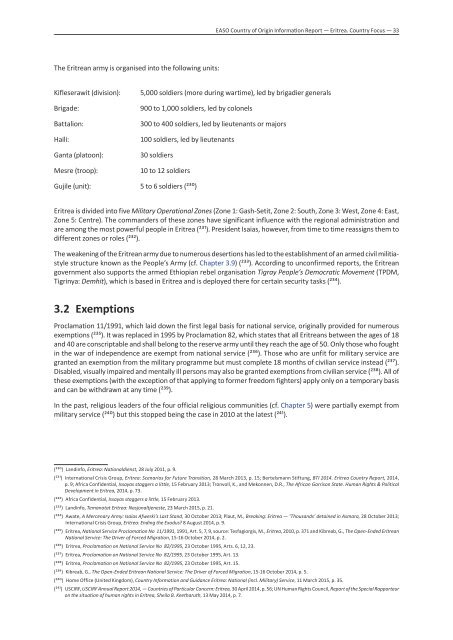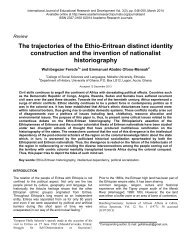You also want an ePaper? Increase the reach of your titles
YUMPU automatically turns print PDFs into web optimized ePapers that Google loves.
EASO Country of Origin Information <strong>Report</strong> — <strong>Eritrea</strong>. Country Focus — 33<br />
The <strong>Eritrea</strong>n army is organised into the following units:<br />
Kifleserawit (division):<br />
Brigade:<br />
Battalion:<br />
Haili:<br />
Ganta (platoon):<br />
Mesre (troop):<br />
5,000 soldiers (more during wartime), led by brigadier generals<br />
900 to 1,000 soldiers, led by colonels<br />
300 to 400 soldiers, led by lieutenants or majors<br />
100 soldiers, led by lieutenants<br />
30 soldiers<br />
10 to 12 soldiers<br />
Gujile (unit): 5 to 6 soldiers (230)<br />
<strong>Eritrea</strong> is divided into five Military Operational Zones (Zone 1: Gash-Setit, Zone 2: South, Zone 3: West, Zone 4: East,<br />
Zone 5: Centre). The commanders of these zones have significant influence with the regional administration and<br />
are among the most powerful people in <strong>Eritrea</strong> (231). President Isaias, however, from time to time reassigns them to<br />
different zones or roles (232).<br />
The weakening of the <strong>Eritrea</strong>n army due to numerous desertions has led to the establishment of an armed civil militiastyle<br />
structure known as the People’s Army (cf. Chapter 3.9) (233). According to unconfirmed reports, the <strong>Eritrea</strong>n<br />
government also supports the armed Ethiopian rebel organisation Tigray People’s Democratic Movement (TPDM,<br />
Tigrinya: Demhit), which is based in <strong>Eritrea</strong> and is deployed there for certain security tasks (234).<br />
3.2 Exemptions<br />
Proclamation 11/1991, which laid down the first legal basis for national service, originally provided for numerous<br />
exemptions (235). It was replaced in 1995 by Proclamation 82, which states that all <strong>Eritrea</strong>ns between the ages of 18<br />
and 40 are conscriptable and shall belong to the reserve army until they reach the age of 50. Only those who fought<br />
in the war of independence are exempt from national service (236). Those who are unfit for military service are<br />
granted an exemption from the military programme but must complete 18 months of civilian service instead (237).<br />
Disabled, visually impaired and mentally ill persons may also be granted exemptions from civilian service (238). All of<br />
these exemptions (with the exception of that applying to former freedom fighters) apply only on a temporary basis<br />
and can be withdrawn at any time (239).<br />
In the past, religious leaders of the four official religious communities (cf. Chapter 5) were partially exempt from<br />
military service (240) but this stopped being the case in 2010 at the latest (241).<br />
(230) Landinfo, <strong>Eritrea</strong>: Nationaldienst, 28 July 2011, p. 9.<br />
(231) International Crisis Group, <strong>Eritrea</strong>: Scenarios for Future Transition, 28 March 2013, p. 15; Bertelsmann Stiftung, BTI 2014. <strong>Eritrea</strong> Country <strong>Report</strong>, 2014,<br />
p. 9; Africa Confidential, Issayas staggers a little, 15 February 2013; Tronvoll, K., and Mekonnen, D.R., The African Garrison State. Human Rights & Political<br />
Development in <strong>Eritrea</strong>, 2014, p. 73.<br />
(232) Africa Confidential, Issayas staggers a little, 15 February 2013.<br />
(233) Landinfo, Temanotat <strong>Eritrea</strong>: Nasjonaltjeneste, 23 March 2015, p. 21.<br />
(234) Awate, A Mercenary Army: Isaias Afwerki’s Last Stand, 30 October 2013; Plaut, M., Breaking: <strong>Eritrea</strong> — ‘Thousands’ detained in Asmara, 28 October 2013;<br />
International Crisis Group, <strong>Eritrea</strong>: Ending the Exodus? 8 August 2014, p. 9.<br />
(235) <strong>Eritrea</strong>, National Service Proclamation No 11/1991, 1991, Art. 5, 7, 9, source: Tesfagiorgis, M., <strong>Eritrea</strong>, 2010, p. 371 and Kibreab, G., The Open-Ended <strong>Eritrea</strong>n<br />
National Service: The Driver of Forced Migration, 15-16 October 2014, p. 2.<br />
(236) <strong>Eritrea</strong>, Proclamation on National Service No 82/1995, 23 October 1995, Arts. 6, 12, 23.<br />
(237) <strong>Eritrea</strong>, Proclamation on National Service No 82/1995, 23 October 1995, Art. 13.<br />
(238) <strong>Eritrea</strong>, Proclamation on National Service No 82/1995, 23 October 1995, Art. 15.<br />
(239) Kibreab, G., The Open-Ended <strong>Eritrea</strong>n National Service: The Driver of Forced Migration, 15-16 October 2014, p. 5.<br />
(240) Home Office (United Kingdom), Country Information and Guidance <strong>Eritrea</strong>: National (incl. Military) Service, 11 March 2015, p. 35.<br />
(241) USCIRF, USCIRF Annual <strong>Report</strong> 2014, — Countries of Particular Concern: <strong>Eritrea</strong>, 30 April 2014, p. 56; UN Human Rights Council, <strong>Report</strong> of the Special Rapporteur<br />
on the situation of human rights in <strong>Eritrea</strong>, Sheila B. Keetharuth, 13 May 2014, p. 7.






